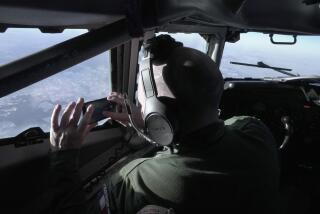U.S., Soviets, Japan to Form Air Alert Link
WASHINGTON — The United States, the Soviet Union and Japan tentatively have agreed to set up a radio warning network aimed at preventing a repetition of the 1983 incident in which the Soviets shot down a South Korean airliner that had strayed into their airspace.
The agreement, which could be made final by the time President Reagan meets with Soviet leader Mikhail S. Gorbachev in November, stems from talks among aviation experts from the three nations that began last February in Washington and concluded Monday in Tokyo.
24-Hour Connection
It would provide a 24-hour radio link among air-traffic control centers in Anchorage, Alaska; Tokyo, and the Siberian city of Khabarovsk. Thus, if a non-Soviet airliner flew off course into Soviet airspace, as did Korean Air Lines Flight 007 nearly two years ago, controllers in Siberia could be alerted, according to a Federal Aviation Administration official who spoke on condition he not be identified.
National security adviser Robert C. McFarlane hailed the plan as a “modest but worthwhile” sign of improving U.S.-Soviet relations, citing the tentative agreement when asked about the climate in which summit preparations are taking place.
“Modest steps--that’s what you have to build on,” McFarlane said in an interview on ABC-TV’s “Good Morning, America.”
Similarly, Transportation Secretary Elizabeth Hanford Dole called the preliminary agreement a “significant step toward enhancement of the safety of civil air traffic in the North Pacific.” The pact requires a further exchange of diplomatic notes and some further negotiations, she said.
When KAL Flight 007 strayed off course, both Japanese and U.S. military air controllers were reported to have been aware of the error but had no means of notifying either the airliner or Soviet air controllers.
Unheeded Challenge
Soviet Far Eastern air command pilots claimed that their challenge to the airliner minutes before it would have returned to international airspace went unheeded, and they shot it down, killing all 269 passengers and crew members aboard.
Officially, the Soviet Union never apologized for its action. Asked if Moscow’s negotiators expressed regrets during the talks, the U.S. official said: “There were no confessions or accusation. The talks were aimed strictly at the future.”
Normal air traffic between North America and Japan and South Korea is handled entirely by Anchorage and Tokyo, although the heavily used Northern Pacific air routes parallel Soviet airspace for much of the distance, coming as close as 75 miles at some points.
U.S. officials also said that Soviet radar can track planes easily from that nation’s Kamchatka Peninsula down past the Kurile Islands, where neither the Anchorage nor the Tokyo air traffic control center has been able to maintain good contact.
More to Read
Sign up for Essential California
The most important California stories and recommendations in your inbox every morning.
You may occasionally receive promotional content from the Los Angeles Times.










